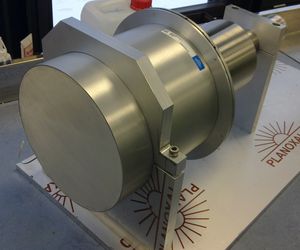Neutron Detektorentwicklung
The official public announcment for this position can be found here.
Reactions in explosive stellar events involve proton capture into excited nuclear states of the new nucleus thus formed. For example, we have a schematic astrophysical reaction like the following: X + p → Y* → Y + γ. The asterisk denotes that nucleus Y is formed in an excited nuclear state, which then promptly de-excites by gamma-ray emission, to the ground state of Y. It is the rate of this reaction, under the astrophysical conditions within nova or x-ray burst explosions that we seek to measure. An important nuclear physics quantity that is essential to determine this rate is the lifetime of the excited nuclear states in Y into which the proton is captured.
In our experiments, we populate the astrophysically important excited states in Y with a transfer reaction, schematically represented as: Z + a → Y* + b. Nucleus "a" for example, could be a deuteron, 3He, or an α particle. Nucleus "b" is called the transfer ejectile; it, too is a light nucleus, such as a proton, deuteron, 3He, or an α particle. (a and b are, of course, different). Once again, the excited nuclear state in Y promptly decays by gamma-ray emission.
By measuring the ejectile particle "b" in coincidence with the gamma-rays from Y*, the lifetime of the excited nuclear states can be determined. More on this can be read on our Doppler Shift Lifetime Station page.
Presently, the facility detects light charged ejectiles (protons, deuterons, tritons, 3He, α) in coincidence with gamma-rays. By measuring the position and energy of the light charged particles, and knowing the specific reaction we have produced, the specific excited state populated in nucleus Y can be determined from reaction kinematics. Imposing a coincidence between ejectiles satisfying "good kinematics" onto the measured gamma-ray spectrum allows the lifetime of the nuclear state to be determined.

Das Projekt
We are looking for enthusiastic undergraduate student(s) looking for a Diploma project to help us extend the capability of this facility. Transfer reactions can also produce neutrons as the light ejectile particle (particle "b" above). And, in fact, some nuclei we wish to study for nova nucleosynthesis can only be (efficiently) produced by choosing a transfer reaction that has a neutron as the light ejectile: Z + a → Y* + n.
We have acquired a new liquid scintillator neutron detector for this pupose. A photo of the detector is shown here. The research project is the development and characterization of the response of this detector to neutrons and gamma-rays. Because it is a scintillator, the detector is capable of "seeing" both neutrons and gamma-rays. Gamma-rays, however, are a background for this detector; we want to avoid having the gamma-ray signals obscure the neutron signals. The scintillator material has the property of producing different electronic pulseshapes depending on whether the interacting particle is a photon or neutron. This allows the experimentalist to discriminate between neutrons and photons on the basis of the detector's output pulseshape.
The prospective project would be to study and characterize the efficiency of this detector for neutron detection and to characterize its ability to discriminate between gamma-rays and neutrons on the basis of digital pulse shape analysis.
Please contact Prof. Shawn Bishop by email or phone for further information.